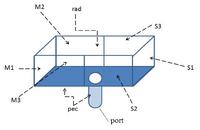Jacky Loh
Junior Member level 1
hexagonal lattice matlab script
I want to use HFSS 11 to simulate periodic triangular array. I refered to the getting started with Foquet ports downloaded from this forum. It descrides a method to model rectangular lattice array. But I have not understood how to model an unit cell. I am concerned with simulate triangular periodic array. Could anyone to help me model the unit cell of this kind array? thank you very much!
I want to use HFSS 11 to simulate periodic triangular array. I refered to the getting started with Foquet ports downloaded from this forum. It descrides a method to model rectangular lattice array. But I have not understood how to model an unit cell. I am concerned with simulate triangular periodic array. Could anyone to help me model the unit cell of this kind array? thank you very much!


